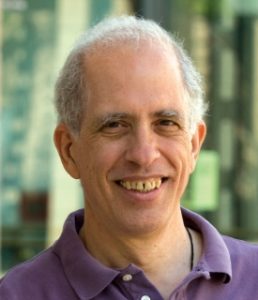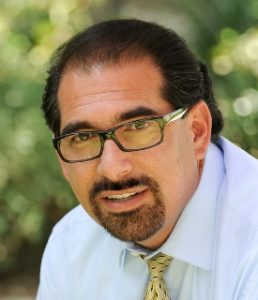Spring Retirements
 Geoff Kuenning joined the computer science faculty in 1998 after a pivotal gathering.
Geoff Kuenning joined the computer science faculty in 1998 after a pivotal gathering.
“After I was offered the Mudd job,” Kuenning says, “my wife and I came back to visit the campus with our brand-new adopted daughter. The entire CS department (then only six people) and their families met at Ran Libeskind-Hadas’s house for an evening of takeout Persian food. The intimacy and warmth of that get-together was a big factor in my decision to join Mudd.”
During his 25 years, Kuenning taught courses on data structures and program development, operating systems, file systems and computer systems performance analysis. He received eight NSF grants and has published numerous articles in prestigious journals and conference publications. Kuenning authored many aspects of the CS curriculum and served as a study abroad advisor and off-campus liaison. He spent almost a decade as the Engineering Clinic director.
Known for his candid conversations, Kuenning is also revered for his mentorship, particularly with junior faculty.
Kuenning’s advocacy for students is also well-known. He often encouraged those who might be reluctant into the CS major. Kuenning says, “It’s really not about the moments; it’s about continuous experiences. My favorite class is CS 5, where I get to bring the breadth and beauty of CS to students who are just starting college. It is truly a joy to see the fascination and eagerness with which they respond.”
Kuenning shared that he plans to ride his bike a lot and hopes to complete a San Francisco-to-Los Angeles ride along Highway 1 during his retirement. He adds, “I will also return to chasing my daughter around the world (she keeps moving), perhaps work on a textbook, and my wife wants me to practice the piano again.”
 Ziyad “Zee” Durón ’81, the Jude and Eileen Laspa Professor of Engineering, is an expert in the full-scale field testing of large structures, including seismic investigations and earthquake engineering. He is a leader in the development of field-test procedures aimed at identifying response characteristics from low-level vibrations that occur naturally in all structures and has developed highly sensitive instrumentation for monitoring hydrodynamic pressure wave propagation for use in seismic investigations of concrete dams. Since entering the field in 1985, Durón has headed more than 20 field tests on a variety of structures, including concrete dams, buildings, bridges and launch vehicles.
Ziyad “Zee” Durón ’81, the Jude and Eileen Laspa Professor of Engineering, is an expert in the full-scale field testing of large structures, including seismic investigations and earthquake engineering. He is a leader in the development of field-test procedures aimed at identifying response characteristics from low-level vibrations that occur naturally in all structures and has developed highly sensitive instrumentation for monitoring hydrodynamic pressure wave propagation for use in seismic investigations of concrete dams. Since entering the field in 1985, Durón has headed more than 20 field tests on a variety of structures, including concrete dams, buildings, bridges and launch vehicles.
After 25 years at Mudd, Durón’s impact has been as big as the dams he works on. He says, “I came to HMC in large part because many of the founding faculty were here, which gave me a lot of access to their thinking about the program, how they built it and how it actually worked. I stayed at HMC because of the students, and it is the students that I will miss the most.”
Durón introduced field experience into the experimental engineering course to give students a real-life example of what engineering in the professional field feels like. He developed several courses for the engineering curriculum, including a design, manufacturing and management program that was dedicated to fostering leadership and professional skills. A colleague noted that Durón “really works to ensure that the department was always ahead of the curve and responding to whatever was happening in the world. He really pushed to expand what we could do in our program and what we offer for our students.”
Durón served as department chair for seven years and brought in significant financial resources for the engineering department.
During retirement, Durón will remain active as a consultant in dam safety and will work with young professional engineers as they build their careers. He says, “I want to thank the College for affording me all the support and resources for what turned out to be a great career.”
The De Pietro Program Legacy
Zee Durón worked with the College and the De Pietro family to launch the Frank and Frances De Pietro Fellowship Program in Civil Engineering.
“The late Franklin De Pietro had a vision that led him and his wife to prominence in Los Angeles during an era when hardworking immigrants in the United States often found opportunities that they had perhaps only dreamed about,” Durón said. “That gift, generously and graciously entrusted to the College, has provided a way for their family values to live on.”
The program was created in 1998 by brothers Robert ’69 and Dennis De Pietro in honor of their parents, Frank and Frances, to support undergraduate research in civil engineering. Robert, an engineering alum, said, “Zee already had a vision and suggested—because of our family’s link in supporting the College—that we might consider something that would have a more lasting value to the student experience.”
Since the launch of the fellowship program, Durón has worked with over 60 fellows on civil engineering projects across California. In May during a Department of Engineering celebration for Durón, 11 former fellows shared their thoughts on the impact of the De Pietro Program and their experiences working with Durón.
Zach Rubin ’08 recalled his first experiences in field engineering. “I was taught to make engineering decisions with the clarity to see the limitations of the work that we do and the integrity to say those limitations out loud.”
Gene Lee ’04 said that through the program and Durón’s guidance, he learned to solve complex, open-ended problems which helped him grow as a team leader who now effectively communicates with his team at the Jet Propulsion Laboratory.
Durón said that hearing about what his students have gone on to do is very humbling. “The goal for me was to create a program that could change the way you [students] think and learn and to create within each of you the ability to be better than I could ever be.”